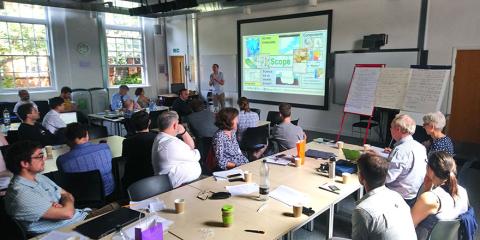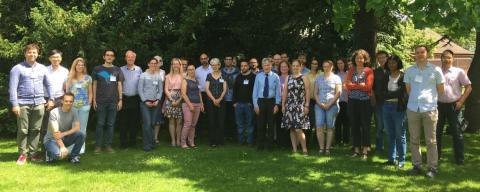The Centre for Ecology & Hydrology (CEH) is a major partner in the UK Environmental Prediction (UKEP) initiative, a national collaboration delivering new research on high resolution interactions between our atmosphere, land and oceans. More than 50 scientists discussed the latest UKEP research at a recent workshop, among them CEH's Toby Marthews, who tells us more about the project…
In Earth System Models, the most usual approach is to model the land, atmosphere and ocean as separate systems. However this leads to limited predictive power, especially when trying to extrapolate the path of hazardous weather events and environmental impacts like flooding, storm surges or poor air quality episodes. Many of these kinds of events in fact occur at the boundaries between the different systems.
Moving to a 'fully coupled' model environment where data is continually exchanged between the component systems is highly desirable, but is technically extremely challenging. The UK Environmental Prediction project is attempting to address this challenge in the context of UK weather and extreme events. It draws in expertise from the UK’s Met Office, Centre for Ecology & Hydrology, National Oceanography Centre and Plymouth Marine Laboratory.
"Moving to a 'fully coupled' model environment where data is continually exchanged between the component systems is highly desirable, but is technically extremely challenging."
Through UKEP, we are developing and evaluating the UK’s first fully coupled regional prediction system at kilometre scale. This uses atmosphere – ocean – wave – land surface – biogeochemistry model components and their interactions to improve the UK’s capability in future operational applications.
Along with my CEH colleague Eleanor Blyth, I attended the June 2019 workshop at the University of Reading to catch up on developments. I also presented on CEH’s contribution to UKEP, which is to coordinate the land surface elements of the new coupled system. A broad range of researchers from the Met Office, NERC centres, universities, government agencies and consultancies working across weather and climate, marine and hydrological science disciplines attended. Assembling a fully coupled system model such as the one envisaged for UKEP necessarily involves collaboration and accessing expertise in many different areas.

In contrast to many science meetings, participants spent the majority of time in small multi-disciplinary teams working to develop research and application proposals. These were framed around three focus areas:
- Estuarine and coastal environments
- Regional coupled prediction for environmental change
- Concurrent and combined natural hazards
We identified gaps in scientific knowledge, modelling and observation capability, and evaluation experiments. We also developed and iterated outline proposals and actions for research and application. These will further progress and demonstrate the skill and use of regional coupled prediction tools.
Of the three major components considered by UKEP (land, atmosphere and ocean), the land surface is obviously of most direct importance to humans because this is our home: this is where the vast majority of us live. However, linkages between the land surface and other biosphere components are often surprisingly little quantified. Making use of the richness of data available in the UK environment, great progress has been made in bringing these differing components into alignment.
For further information on the workshop outcomes and the UK Environmental Prediction collaboration, please see the project website or contact Huw Lewis, project lead.
